Chef Arvind Rai goes into the historicity of mango and its contemporary usage. By Team Viva
Which fruit can be had in its raw form as well as when is it ripe? What lends itself to pickles, chutneys, soufflés, drinks, ice creams and cakes? What can be added to dals for a nice texture or eaten on its own as a dessert? Of course, the answer is none other than mango. And in India, the varieties are innumerable. While the Hapus or alphonso holds sway in the western parts, the Dussehri, Langda and Chausa are the favourites in the Hindi belt. Of course, Andhra loves it Baganpalli and Bengal its Malda.
History yields some very interesting facts and figures about this celebrated fruit. Fossils indicate that the mango made its first appearance between 25 to 30 million years ago in Northeast India, Myanmar and Bangladesh, from where it travelled down to southern India. The earliest name given to the mango was Amra-Phal. It is also referred to in early Vedic literature as Rasala and Sahakara, and is written about in the Brihadaranyaka Upanishad and the Puranas, which condemn the felling of mango trees. Over the ages, the mango became a household fruit and odes were sung in its praise. Legendary Urdu poet Mirza Asadullah Khan Ghalib was a mango aficionado, too. He despised people who didn’t share his addiction for the fruit. Mughal emperor Akbar is said to have planted over 100,000 mango trees in Darbhanga (modern Bihar).
So how do you judge whether a mango is ripe enough to be eaten? Squeeze gently. If it is ripe, it will give in to a slight fingertip pressure and will smell sweet at the stem end. An unripe mango has a sour taste and an astringent effect on your tongue and lips. So choose carefully if you’re planning to eat it the same day. Also, be careful to choose the fruit which has a fully intact skin that’s free of any bruises or cuts.
Mangoes are one of the most versatile fruits. You can serve ripe mango slices in compotes, cakes and tarts or alongside grilled or roasted meats and poultry. You can purée mango and use it as a base for sherbets, whips, ice cream, beverages and dessert sauces. You can eat it out of hand, peeled like a banana or on the half shell. Or you can gently roll and knead the mango until all of the pulp inside is mashed and liquefied, then simply tap a hole at one end and suck the fruit dry. Mango has a flavour affinity for apricot, avocado, chicken, chillies, cilantro, cucumbers, fish, lime juice, orange, passion fruit, pineapple, rum, seafood, star fruit, sweet bell pepper and tangerine.
While this has clearly become the most versatile ingredient in the kitchen these days, today mangoes can be used in each of the 12 courses of a meal. A large number of mango-festivals that are held these days tells us of the paramount importance that the fruit has. When we speak of nutrition, mangoes are rich in vitamins A, B, and C and a good source of potassium. One medium-size mango has about 150 calories. Mangoes are a rich source of anti-oxidants like quercetin, astragalin and gallic acid that have been proven to fight against certain types of cancers.
Hence, it can be said that it is rightly the brightest yellow in the kitchen. It is such a celebrated fruit that in season, it can be used in myriad ways and when off season, it is used to make condiments. Mango and its variants are indeed the best that India has to offer to global cuisine.
(Rai is executive chef at The Ashok, ITDC.)


























